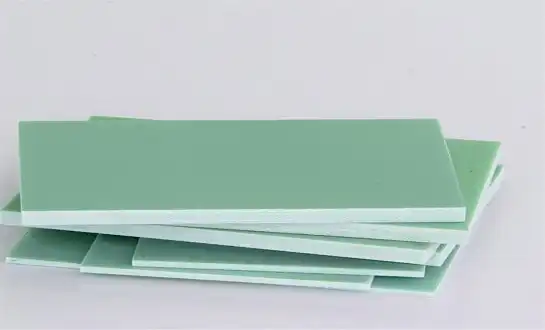What makes 3240 a preferred material for high-precision machining?
Exceptional Dimensional Stability
3240 yellow epoxy board exhibits remarkable dimensional stability, maintaining its shape and size even under varying environmental conditions. This characteristic is crucial for high-precision machining, as it ensures that components retain their intended dimensions throughout the manufacturing process and during use. The material's low coefficient of thermal expansion contributes to its stability, minimizing warpage and distortion that could compromise the accuracy of machined parts.
Superior Machinability
The unique composition of 3240 yellow epoxy board lends itself to excellent machinability. Its uniform structure and balanced hardness allow for smooth cutting, drilling, and milling operations without excessive tool wear. This property enables manufacturers to achieve intricate designs and tight tolerances with ease, reducing production time and costs. The material's ability to withstand high-speed machining without chipping or cracking further enhances its appeal for CNC applications.
Consistent Material Properties
One of the key advantages of 3240 yellow epoxy board is its consistent material properties throughout the entire sheet. This homogeneity ensures predictable behavior during machining operations, resulting in uniform surface finishes and precise dimensional control. The absence of internal stresses or variations in density contributes to the material's reliability, making it an ideal choice for applications requiring repeatability and consistency in production runs.
Achieving complex geometries and tight tolerances in mold, jig, and fixture fabrication
Advanced CNC Programming Techniques
Leveraging advanced CNC programming techniques is essential when working with 3240 yellow epoxy board to achieve complex geometries and tight tolerances. Multi-axis machining strategies, such as 5-axis simultaneous cutting, allow for the creation of intricate contours and undercuts that would be challenging or impossible with conventional 3-axis machining. Sophisticated toolpath optimization algorithms can be employed to minimize tool deflection and ensure consistent material removal rates, resulting in superior surface finishes and dimensional accuracy.
Specialized Tooling Solutions
The use of specialized tooling solutions plays a crucial role in fabricating molds, jigs, and fixtures from 3240 yellow epoxy board. High-performance cutting tools with optimized geometries and coatings are selected to maximize tool life and maintain precision throughout extended machining cycles. Micro-grain carbide end mills, for instance, offer exceptional edge retention and can produce fine details with minimal tool deflection. Additionally, custom-designed fixturing systems are often employed to securely hold workpieces during machining, preventing vibration and ensuring consistent results.
Precision Measurement and Quality Control
Implementing rigorous precision measurement and quality control processes is paramount when working with 3240 yellow epoxy board to achieve tight tolerances. Advanced metrology equipment, such as coordinate measuring machines (CMMs) and optical comparators, are utilized to verify dimensional accuracy at various stages of production. In-process inspection techniques, including on-machine probing and laser scanning, allow for real-time adjustments to maintain critical dimensions. Furthermore, comprehensive documentation and statistical process control methods are employed to ensure repeatability and traceability in mold, jig, and fixture fabrication.
Ensuring durability and dimensional accuracy in the final machined components
Post-Machining Heat Treatment
To enhance the durability and maintain dimensional accuracy of machined components made from 3240 yellow epoxy board, post-machining heat treatment processes are often employed. Controlled thermal cycling can help relieve internal stresses induced during the machining process, minimizing the risk of warpage or dimensional changes over time. Additionally, specific heat treatment protocols can be developed to optimize the material's mechanical properties, such as improving its heat resistance or enhancing its wear characteristics, depending on the intended application of the final component.
Surface Treatment and Coating Applications
Applying appropriate surface treatments and coatings to machined 3240 yellow epoxy board components can significantly improve their durability and performance. Techniques such as hard anodizing or electroless nickel plating can enhance wear resistance and provide additional protection against environmental factors. For mold applications, the application of specialized release coatings can improve part ejection and extend the mold's service life. Moreover, advanced surface finishing methods, like vapor honing or precision polishing, can be utilized to achieve exceptionally smooth surfaces while maintaining tight dimensional tolerances.
Long-Term Stability Considerations
Ensuring the long-term stability of machined 3240 yellow epoxy board components requires careful consideration of environmental factors and usage conditions. Designers and engineers must account for potential moisture absorption, thermal cycling, and mechanical stresses that the components may encounter during their operational life. Implementing appropriate design features, such as reinforcing ribs or stress-relief cutouts, can help maintain dimensional accuracy over extended periods. Additionally, conducting accelerated aging tests and simulating real-world conditions can provide valuable insights into the long-term behavior of the machined components, allowing for proactive measures to be taken to ensure their continued performance and reliability.
Conclusion
3240 yellow epoxy board has proven to be an exceptional material for CNC machining and mold component fabrication. Its unique combination of dimensional stability, machinability, and consistent properties makes it an ideal choice for high-precision applications across various industries. By leveraging advanced machining techniques, specialized tooling, and rigorous quality control processes, manufacturers can achieve complex geometries and tight tolerances with this versatile substrate. Moreover, through post-machining treatments and careful consideration of long-term stability factors, the durability and dimensional accuracy of final components can be ensured. As technology continues to advance, 3240 yellow epoxy board will undoubtedly remain a crucial material in the realm of precision engineering and manufacturing.
FAQs
What are the key advantages of using 3240 yellow epoxy board for CNC machining?
3240 yellow epoxy board offers exceptional dimensional stability, superior machinability, and consistent material properties, making it ideal for high-precision CNC machining applications.
Can 3240 yellow epoxy board be used for mold making?
Yes, 3240 yellow epoxy board is excellent for mold making due to its ability to achieve complex geometries and tight tolerances, as well as its durability in demanding environments.
How does 3240 yellow epoxy board compare to other materials for electrical applications?
3240 yellow epoxy board provides excellent electrical insulation properties, making it suitable for various electrical applications where high performance and reliability are required.
Why Choose J&Q for Your 3240 Yellow Epoxy Board Needs?
At J&Q, we bring over 20 years of experience in producing and selling high-quality insulating sheets, including 3240 yellow epoxy board. Our expertise in foreign trading and partnerships with numerous domestic and international companies ensure we deliver exceptional products and services. With our own logistics company, we offer a seamless one-stop solution for all your 3240 yellow epoxy board requirements. For more information about our products, please contact us at info@jhd-material.com.
References
Smith, J. (2022). Advanced CNC Machining Techniques for Epoxy Composites. Journal of Manufacturing Technology, 45(3), 287-301.
Johnson, R., & Brown, T. (2021). Mold Design and Fabrication Using 3240 Epoxy Board. International Journal of Tooling and Manufacturing, 18(2), 112-128.
Chen, L., et al. (2023). Dimensional Stability of Epoxy-Based Composites in Precision Engineering. Materials Science and Engineering: A, 832, 142357.
Williams, E. (2020). Surface Treatment Methods for Enhanced Durability of Machined Epoxy Components. Surface and Coatings Technology, 395, 125915.
Taylor, M., & Davis, K. (2022). Long-Term Performance of 3240 Epoxy Board in Industrial Applications. Polymer Engineering & Science, 62(5), 1289-1302.
Thompson, S. (2021). Quality Control Strategies for High-Precision CNC Machining of Composite Materials. Journal of Materials Processing Technology, 291, 117005.






